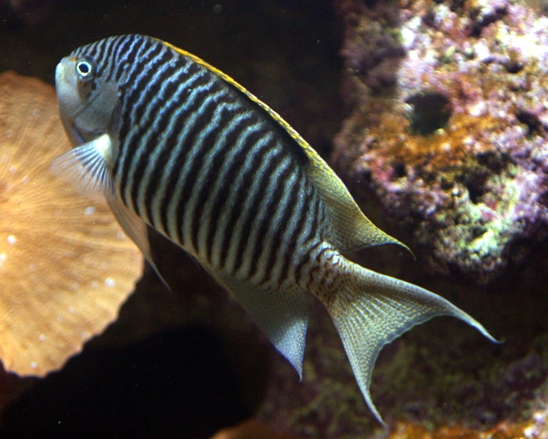Description: Zebra angelfish, also known as Zebra lyretail, are sexually dimorphic (males and females differ in appearance). The female is light blue with a black band covering the eyes and black stripes at the top and bottom of the tail. In contrast, the male is pale blue, with the zebra pattern of multiple thin, dark, vertical stripes. Both the male and female have a long forked tail, a small mouth and a spine located on the lower curve of the cheekbone.
Size: The Zebra angelfish grows to a length of up to 10 inches (25 cm).
Behavior: In contrast to many other angelfish, which live in pairs, swallowtail angels, in the genus Genicanthus, live with a dominant male guarding a harem of females. If the male dies, the dominant female will become male and take charge of the harem. All Zebra angelfish start life as females and are able to turn into males later in life (protogynous hermaphrodites).
Diet: These fish eat zooplankton (tiny invertebrates that float freely in the water column). Their days are spent swimming freely in open waters and taking refuge in the coral reefs at night.
Communication: They perform courtship rituals that consist of fluttering displays. The male positions himself alongside the female and his whole body quivers or vibrates.
Reproduction: Zebra angelfish fertilize their eggs externally. The male and female rise up in the
water column together, releasing a cloud of gametes as they near the surface. After fertilization the buoyant eggs float in the water column until they hatch.
Habitat/range: Zebra angelfish inhabit steep slopes in moderate to deep waters and are found only in the Red Sea and the Western Indian Ocean.
Status: Listed as Least Concern on IUCN Red List.



